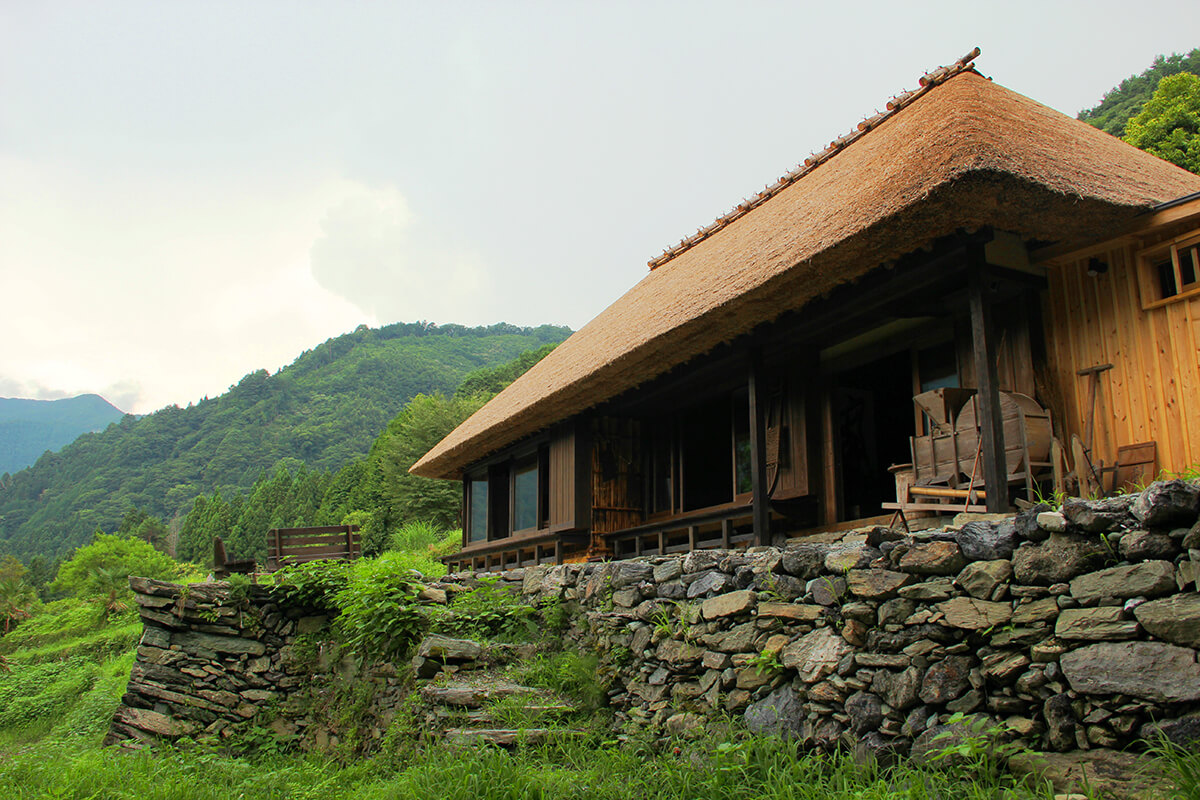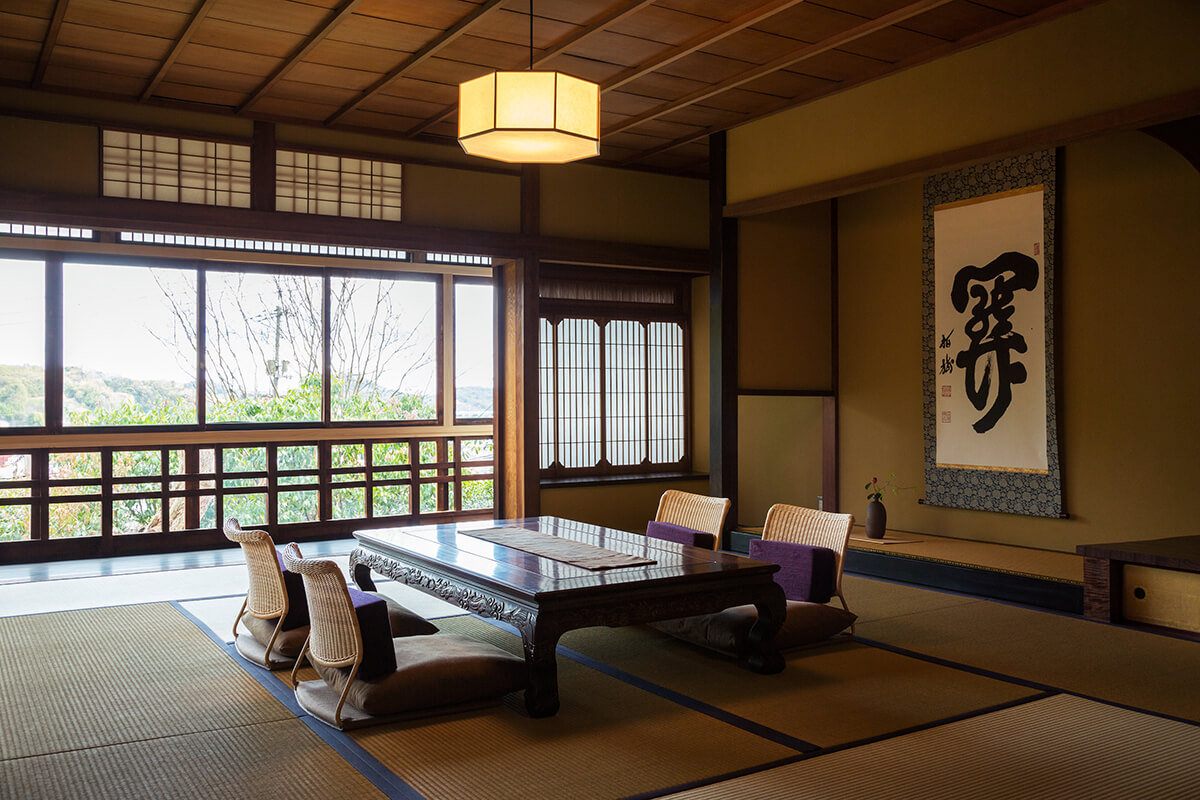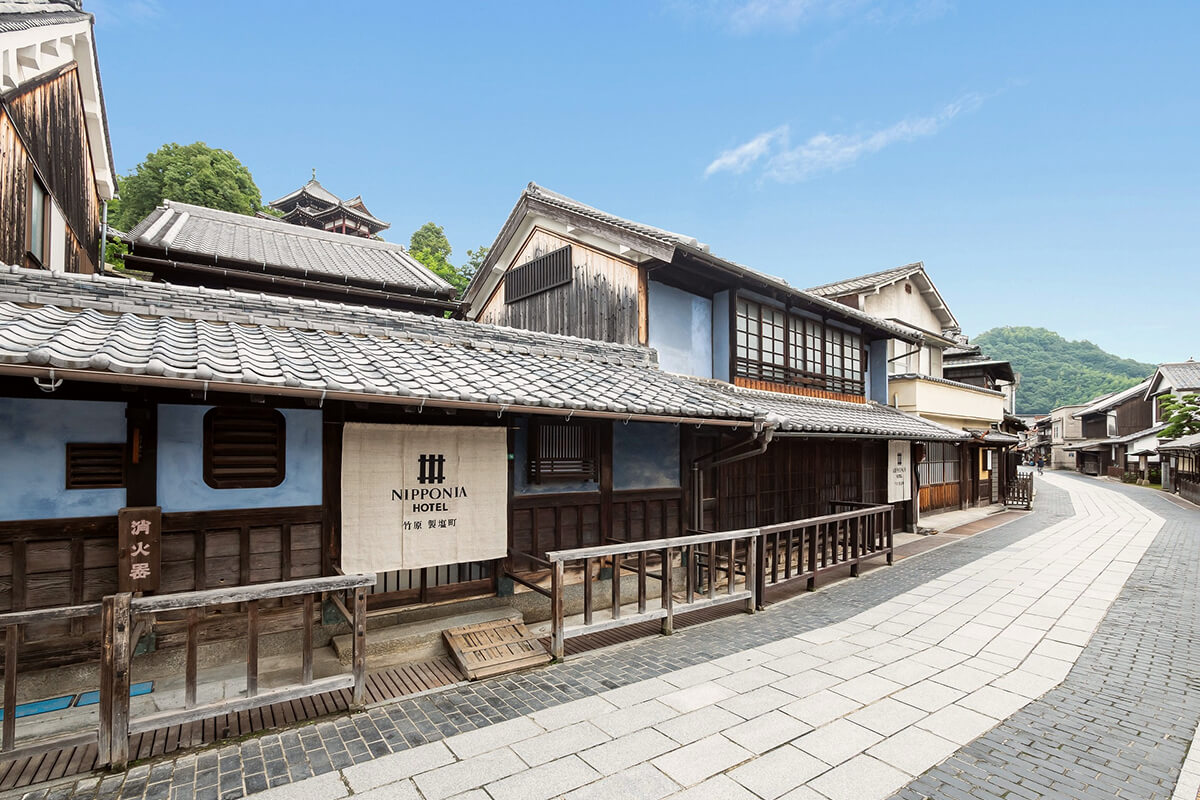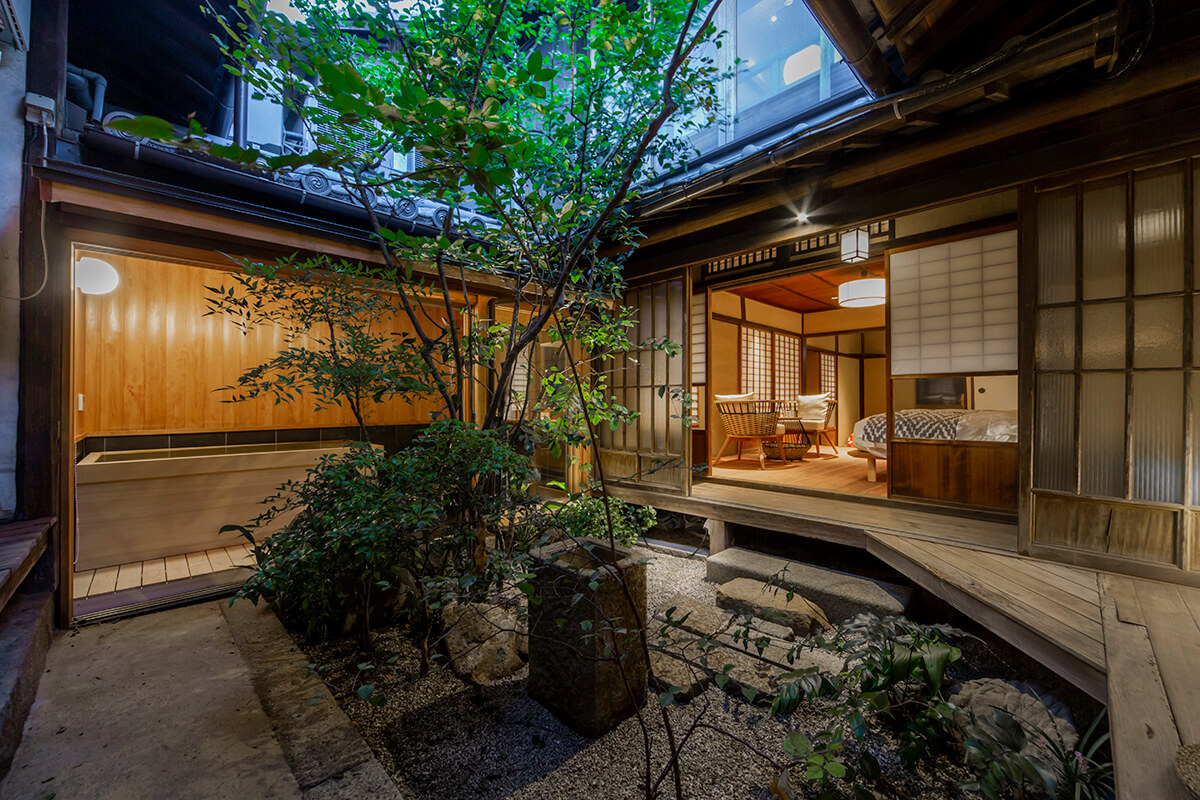A RYOKAN OF YOUR OWN

The drive from the city of Miyoshi to the Chiiori (chiiori.org) farmhouse winds through Japan’s scenic Shikoku island known for its dramatic Iya Valley and thatched-roof cottages. A few miles of twists and turns past the train station at Ōboke is the last retail shop, and a few miles later, the last stoplight. Then the last paved road turns into a labyrinth of hairpin switchbacks weaving between towering cedar trees. Chiiori appears suddenly, its massive thatched roof atop glass walls, smoke billowing from its peak.
This kominka (a Japanese term that translates to “old house”) is both the first and last of its kind, and the experience of staying in such a place is catching on across Japan in both rural and urban centers. National and regional governments have begun to support the painstaking transformation of historic structures. Funding such work has been revolutionary in a country long committed to technology and progress. “After the war, we had to revitalize this country and everyone was focused on creating something new and efficient and modern, and that kind of destroyed our authenticity,” says Mika White, CEO of the Nagasaki-based travel marketing company Chapter White. “But Japan is finally coming to a point where these traditional houses and crafts are seen as valuable.”
Chiiori is one of the oldest farmhouses in the region, built during the Genroku era (1688–1704) from pine, cedar, and chestnut laid atop stones, with no concrete foundation and nary a hammered nail holding all that wood together. Yet amid this antiquity is the unmistakable air of something new. It’s hardly modern, with its shoji screens and irori (Japanese hearths), but those who have lived in this part of the valley for the past half-century know that this ancient farmhouse has seen its share of renovations, from a new roof in the 1970s to large-scale repairs started in 2011 by owner and American author Alex Kerr. The work was as much a preservation effort as it was a modernization project, using the same building practices the farmers used during the Edo period (1603–1868), but adding a contemporary wing and modern kitchen, and ultimately initiating a new trend in authentic Japanese accommodations. Its opening in 2012 as Japan’s first exclusive-use kominka offered guests a piece of local culture all to themselves.
Indeed, Chiiori has many successors—from a modernized geisha school in Tokyo to an old merchant’s house in the seaside city of Tomonoura—each of which offers a new authenticity, pulling back the curtain on Japanese culture, flavor, and history in a way that no luxury hotel has managed to do before.

GEISHA’S GATEWAY
Kakurenbo Yokocho certainly lives up to its name. The clandestine street in Tokyo’s Kagurazaka neighborhood roughly translates to “hide and seek”—and when you first set out for Trunk (House) (trunk-house.com), you’ll no doubt feel as though you’re wandering the little unmarked alleyway lost. But then, a young man dressed all in black with a kind smile will lean close and say your name as you walk by. Bewildered, you’ll nod, and as he turns to walk deeper into the warren of backstreets (your luggage now magically in his hands), you’ll follow him silently to a concrete, stone, and wooden façade. The combination of a pine tree in an entrance and a black fence was a symbol of a place of geisha; for the average traveler here, it’s merely a Zen-like interlude away from the busy streets outside.
Opened in September 2019, Trunk (House) brings the townhouse hotel to Japan’s biggest city, turning a 70-year-old geisha house into a one-room hotel where a butler and a private chef serve up everything from Chanoyu tea ceremonies and elegant French/Japanese fusion dinners to strong gin and tonics and intricate mochis topped with edible gold for dessert. It’s a reinterpretation of the Tokyo salons of another era, but look closer and nearly everything has a modern twist: The Jean Prouvé and George Nelson furnishings, the indigo-dyed linen nightshirts in lieu of traditional suteteko, and the shunga artwork above the cypress bathtub that has a decidedly scandalous overtone. There’s even a private disco (said to be Tokyo’s smallest) where downing Yamazaki 18 and singing karaoke until the wee hours of the morning isn’t just possible—it’s encouraged. Your butler will make sure your glass never goes empty, and come morning, he’ll make sure there’s plenty of miso soup and steamed rice to nurse any residual headache.

BETWEEN TWO ERAS
There are 100 stairs in all, give or take, between Onomichi’s main road and LOG (l-og.jp). That’s only halfway to the city’s most famous landmark, the Daidō-era Senkōji Temple built in the ninth century, but it’s a laborious path on foot, which is the only way to travel along the stone-clad lane. Once you’ve made it to the hotel (with the help of the rather fit staff, of course), you’ll find that LOG, or Lantern Onomichi Garden, is a new, pink-hued modernist structure carved into the side of Mount Senkō-ji. Designed by the Indian architecture firm Studio Mumbai, the former apartment complex turned hip hideaway is anything but an old house. It has a bar that serves Champagne and sake with views of the Onomichi Channel, a restaurant where the pancakes at breakfast are as expertly prepared as the shabu-shabu at dinner, and a gallery where Studio Mumbai’s creative process for the project has been frozen in time, with color trials and research materials artfully displayed.
Though LOG is home to six minimalist hotel rooms, the property’s Izumo House (above; minatonoyado.jp) is what makes the uphill trek truly worthwhile. Hidden among the trees at the edge of Mount Senkō-ji, Izumo House has shared this sacred area of Onomichi with temples and shrines since the Edo period. A glimpse into how the people of this Hiroshima port city lived back then (and still live today), the estate was restored without any modern-day machinery, to maintain not only its historic integrity but also the peace of this quiet neighborhood. Pristine and minimal, Izumo is home to a sprawling tatami room with views over Onomichi, as well as a second-floor bedroom, a deep Hinoki wood tub in a green-tiled bathroom, a full kitchen, a living room, and a tearoom specially designed for sencha ceremonies. Moving between the historic setting of Izumo House and the modern amenities at LOG, there’s a sense of straddling eras, high above the city and in the cradle of one of Japan’s most revered landmarks.

ABOVE THE SALT
Known as Hiroshima’s Little Kyoto, the Hiroshima Prefecture city of Takehara has the look and the history but none of the overtourism of its sister city. The Old Town is as simple and perfect as you’d imagine old Japan once was, lined with Meiji-era houses and century-old sake breweries and salt houses (the port city was Japan’s leading maker of both for hundreds of years). Hidden in plain sight among them, behind latticed-wood façades and linen noren hangings flapping in the breeze, is Nipponia Hotel Takehara Saltworks Town (nipponia-takehara.com), which opened in August 2019 among a handful of kominka scattered throughout the ancient district.
Inside, Nipponia has an air of modernity laced into its historic structures. Old sake drums line the entrance to Moso, a Meiji-era mansion and brewery where the contemporary furnishings are minimal yet crisp, a cross between the aesthetics of Muji and Tom Dixon, with hanging pendant lamps and subtle, mid-century modern touches. But original details abound, from the old wooden staircases to the engawa hallways that surround the house. Fill up your onsen bath with the touch of a button, then swap your Western look for a yukata and head back out to the streets of Old Town. Just across the way, another kominka is home to Nipponia’s restaurant, where the nightly eight-course menu is brimming with local specialties from the sea, including Farm Suzuki oysters from the Seto Inland Sea (sprinkled with Takehara salt, of course) and seasonal foie gras with squid ink. Back in the privacy of your own kominka, there’s a tatami room for meals, as well as a garden—complete with light installations by a local artist—and a small tatami teahouse for ceremonies, depending on room type.

ROW HOUSE
A sense of history pervades throughout the port town of Tomonoura, nestled into a bay overlooking the Seto Inland Sea National Park. For centuries, it has served as the muse of poets and artists, for its Fukuzenji Temple (which has been said to have the most beautiful views in all of Japan) and, today, for its well-preserved streetscapes of Meiji and Edo period structures. Not far from the waterfront, one of Tomonoura’s oldest roya—a merchant’s house where oars and other ship parts were fashioned—has become a four-bedroom kominka where guests can soak in this storied destination’s past.
Opened in August 2019, Tomonoura Shiomachi Hotel Roya (shiomachi-hotel.com) is the brainchild of Tokyo-based design firm Studio Wasabi, combining the historic artifacts of the structure’s origins (with gabled roofs and rough-hewn wooden oars hanging on the walls) with contemporary design (a gold-flecked wall and open-air cypress bathrooms). The two worlds merge seamlessly, making room for tradition and trends alike with private Japanese gardens decorated with colorful pillows and a café where you can just as easily sip Suntory as Hiroshima’s latest craft gin. (Don’t miss the sea-bream burger—it’s a Tomonoura specialty.) In this 20th-century kominka, guests can fully and deeply immerse themselves in the local culture, donning yukatas and shakily making their way atop wooden geta flip-flops through the town’s uneven stone roads and staircases to dip into onsens and dine on kaiseki at Roya’s sister properties (modern hotels though they are). And when night falls on this historic slice of southern Japan, without a car in sight and only the occasional passerby clad in traditional garb, obi slung low and lazily after a long day, you’ll easily imagine that this scene is just as it was centuries ago.